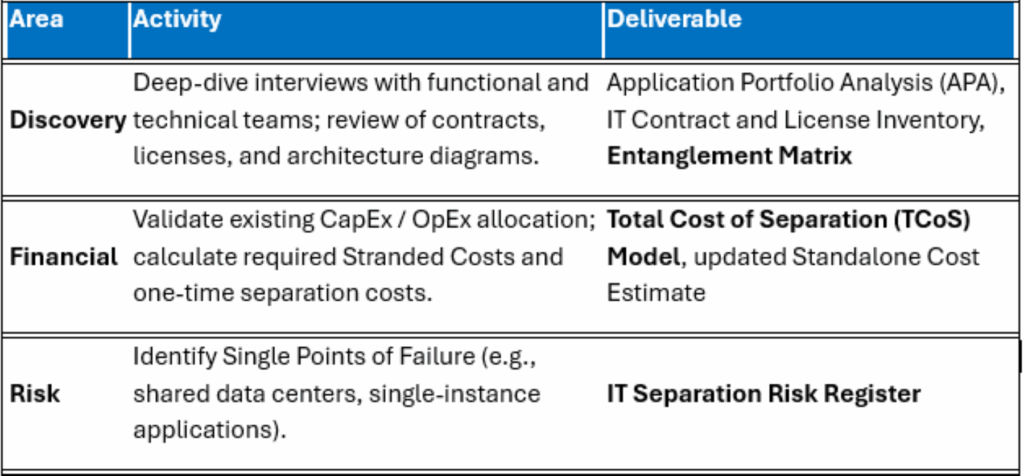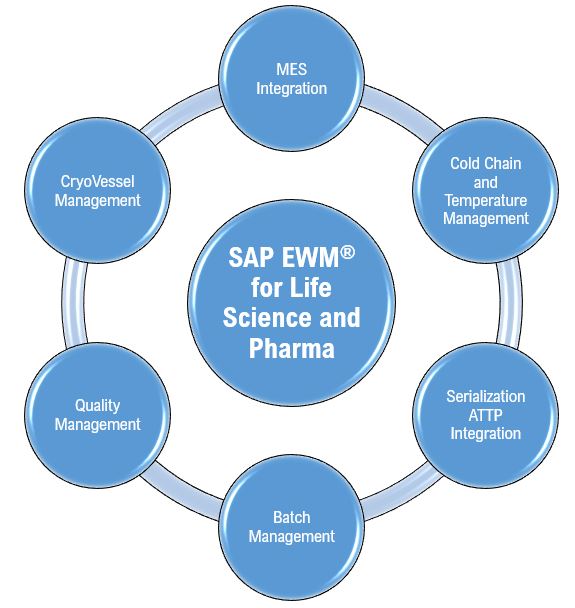IT Carve-outs, the separation of a business unit’s technology assets, infrastructure, and services from its parent company, are among the most complex and risk-laden projects in M&A. When poorly executed, they lead to significant business disruption, value leakage, and protracted transition service agreements (TSAs). This whitepaper outlines a comprehensive consulting methodology across five critical phases—from Due Diligence to Optimization—designed to ensure a clean break, Day-1 operational readiness, and the establishment of a standalone, value-accretive Target State for the divested entity (NewCo) and minimal impact on the retaining entity (RemainCo).
1. Post-Deal Due Diligence (The Deep Dive)
While initial, high-level IT diligence occurs pre-deal, the true depth of entanglement is uncovered in the post-deal phase, transforming initial assumptions into actionable plans.
Focus & Objectives
- Validate Initial Assumptions: Verify the preliminary IT assessment from the pre-deal phase (Vendor Due Diligence or Buy-Side Diligence)
- Establish Separation Perimeter: Finalize the precise scope of technology, systems, contracts, data, and personnel that transfer to NewCo (In-Scope) or remain with RemainCo (Out-of-Scope)
- Quantify Standalone Costs & Separation Risks: Develop a granular estimate of the one-time separation costs (e.g., system replication, data migration) and the ongoing Standalone Operating Model (SOM) costs for NewCo. Identify critical “red flags” and dependencies (e.g., highly integrated ERP instances, proprietary data sharing).
- TSA Baseline: Begin defining the necessary Transitional Service Agreements (TSAs)—what services RemainCo must temporarily provide to NewCo (e.g., email, network access) and for what duration and cost.

2. Target State Design (The Blueprint)2
The Target State Design (TSD) defines the ideal future for NewCo’s technology landscape, moving beyond simple replication to designing a fit-for-purpose, cost-optimized, and strategic IT environment.
Focus & Objectives
- Define Target Operating Model (TOM): Establish the organizational structure, processes, and technology stack NewCo will operate on post-separation.
- Optimize for Strategy: Ensure the new IT environment aligns with NewCo’s independent business strategy (e.g., cloud-first, SaaS adoption, specific security requirements). This is the primary value-creation lever.
- De-Risk & Cost-Optimize: Minimize reliance on legacy RemainCo systems, reducing the scope and duration of expensive TSAs.
Key Consulting Activities
- Future-State Architecture: Design the new network, compute, data centre (or cloud) presence, and security architecture. This often involves a Cloud Strategy review to determine PaaS/IaaS/SaaS adoption.
- Application Strategy: Decide on the fate of each application: Retain/Replicate (for proprietary/core systems), Replace (for non-core, shared systems), or Retire.
- Data & IP Strategy: Define a clear plan for the extraction, cleansing, and migration of historical and operational data, ensuring legal and regulatory compliance.
- Organization & Governance: Design the NewCo IT team structure, required skill sets, and new IT governance processes.
3. Separation Roadmap (The Plan)
The Separation Roadmap is the detailed, phased project plan that bridges the Current State (embedded) with the Target State (standalone).
Focus & Objectives
- Timeline and Dependencies: Create a clear, phase-gated timeline aligned with the overall transaction milestones (Sign, Close, TSA Exit). Highlight critical path dependencies.
- Day-1 Readiness Plan: Focus intensely on the minimum viable set of systems and services required for NewCo to operate legally and functionally from the moment the deal closes (Day-1).
- TSA Exit Strategy: Detail the plan for migrating each shared service, explicitly linking the project milestones to the termination of the corresponding TSA.
Key Consulting Activities
- Workstream Mobilization: Launch the Separation Management Office (SMO) and individual IT workstreams (e.g., Infrastructure, Applications, Data, Security).
- Phasing Strategy: Define waves of separation: Wave 1 (Day-1) for critical minimum services; Wave 2 (Day-100) for stabilization; and Wave 3 (Full Standalone) for TSA exits.
- Cutover Planning: Create the high-fidelity, minute-by-minute plan for the actual physical and logical separation and migration of systems and data, typically over a weekend.
- TSA Negotiation Support: Develop the final scope, service levels (SLAs), and pricing model for the Transition Service Agreements, ensuring favorable terms for NewCo and clear exit criteria.
4. Transaction Execution (The Go-Live)
This phase is the intense period from deal signing to closing, where the separation roadmap is implemented and the business is made ready for its new reality.
Focus & Objectives
- De-coupling and Migration: Execute the separation plan, migrating data, cloning systems, and building the NewCo IT environment in parallel with RemainCo operations.
- Testing and Validation: Rigorously test all new or migrated systems, processes, and interfaces to ensure business continuity post-close.
- Change Management: Manage the transition of IT staff, end-users, and processes to the new environment.
Key Consulting Activities
- Technical Implementation: Build the new network, deploy user hardware, clone/replicate core application instances (e.g., ERP, CRM), and perform initial data extraction.
- Security Stand-up: Implement NewCo’s independent security policies, Identity and Access Management (IAM), and perimeter defenses.
- Parallel Business Testing: Conduct extensive User Acceptance Testing (UAT) and Business Readiness Testing to validate NewCo’s ability to execute core processes (Order-to-Cash, Procure-to-Pay) in the new environment.
- Cutover and Day-1 Support: Lead the final migration activities and establish a dedicated, hyper-care support team for the first 100 days post-close.
5. Operate and Optimize (The Value Realization)
The final phase moves NewCo beyond Day-1 readiness to a sustainable, independent entity focused on maximizing its long-term strategic value.
Focus & Objectives
- Stabilization: Ensure all systems are fully stable, with no lingering critical issues and a smooth handover from the separation team to the permanent NewCo IT organization.
- TSA Exit: Systematically execute the migration projects to terminate all Transition Service Agreements as planned, eliminating dependency and recurring costs.
- Value Realization: Drive the implementation of the strategic components of the Target State Design to achieve the planned cost savings, operational efficiencies, and business growth objectives.
Key Consulting Activities
- TSA Exit Program Management: Manage and execute the final projects (e.g., migrating off shared ERP to a new SaaS solution) required to eliminate the TSA.
- Operational Handover: Formalize and transfer all operational documentation, runbooks, vendor relationships, and IT governance to the permanent NewCo IT leadership.
- Cost Optimization Review: Review the new run-rate costs against the initial Standalone Cost Model. Identify opportunities to further optimize cloud spend, license utilization, and vendor contracts.
- Future-Proofing: Finalize the remaining strategic IT initiatives (e.g., advanced analytics, digital transformation projects) that will drive NewCo’s independent value proposition and competitive advantage.
Conclusion: The Consulting Imperative
Successful IT Carve-outs are not merely technical projects; they are complex business transformations requiring integrated strategic, financial, and technical expertise. Consulting partners play a vital role by bringing a structured methodology, a deep understanding of entanglement, and experience in negotiating TSAs and executing Day-1 cutovers. By adhering to this phased blueprint, organizations can successfully navigate the complexities of separation, minimize operational risk, and unlock the true, independent value of the divested entity.








